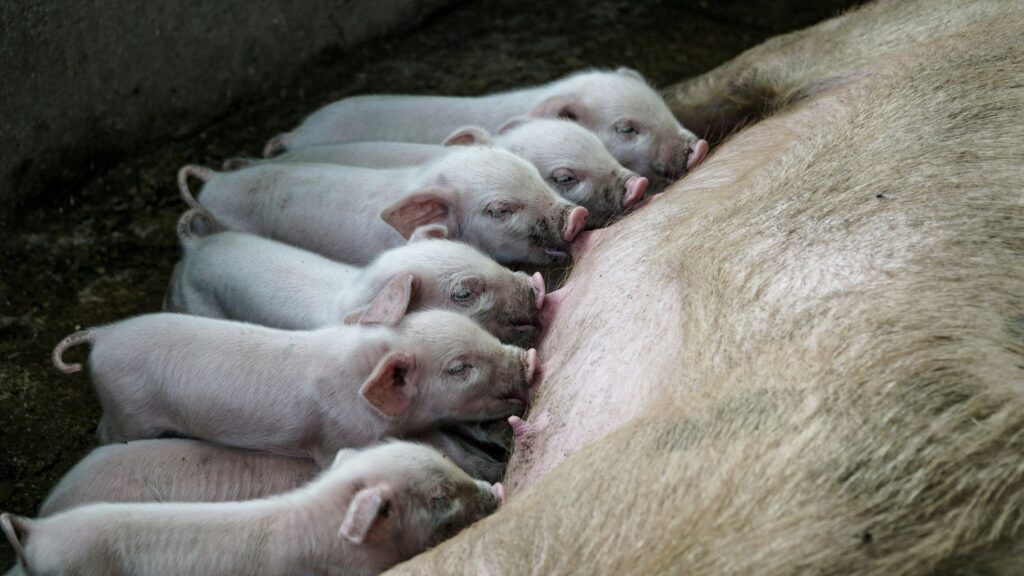
On a quiet morning not long ago, a young farmer I know came to me with a heavy heart. Her name is Ruth — not her real name — a bright, determined third-year secondary school student who manages to balance her studies with small-scale farming. She keeps free-range chickens, a goat, and a few pigs. From her little farm, she feeds her siblings and pays part of her school fees.
Ruth’s story is one of courage and resilience. Her mother left when she was still young, and her father works in Nairobi. Yet she has refused to give up on her dreams. Through farming, she has found both hope and purpose. But recently, she faced a setback that nearly crushed her spirit — the painful loss of her sow and her newborn piglets.
This story isn’t just about one farmer’s misfortune. It’s a reminder to all pig keepers — new or experienced — that breeding and farrowing (pig birthing) require attention, preparation, and care. Mistakes or oversights during this stage can lead to stillbirths, loss of piglets, or even the death of the sow.
Let me share what happened to Ruth — and more importantly, what all pig farmers can learn from her experience.
The Day Ruth Came for Boar Services
On 27th July this year, Ruth came to me requesting boar services. She suspected her sow was on heat and ready to be served. As is my custom, I inspected her sow before agreeing.
Indeed, the sow was on heat — restless, swollen vulva, standing still when touched at the back — all the right signs. But one thing worried me: her weight. She looked rather small, underdeveloped, not quite ready for breeding.
I shared my concern, advising that she should wait a bit longer until the sow had matured properly. A mature gilt (first-time female pig) should ideally weigh at least 90–100 kg before serving. That ensures her body can handle pregnancy and lactation without strain.
Read more on The Right Time to Breed Your Sow: Heat Signs, Maturity & Weight
But Ruth, eager and hopeful, insisted. She needed piglets to expand her small herd and saw this as an opportunity to make progress. Out of compassion and respect for her determination, I agreed — with the understanding that she would pay me later with one piglet from the litter, as she didn’t have the Kshs. 1,000 I usually charge.
I didn’t know that months later, that agreement would turn into one of the most heartbreaking stories I’ve heard in my years of working with farmers.
The Heartbreaking Visit
A few months after the service, schools had just closed for the third term. I expected to see Ruth cheerful and full of plans for her short break. Instead, she came to my home looking weary and defeated.
She sat down, took a deep breath, and began to narrate her ordeal.
Her sow had stopped eating three days earlier. She assumed it was part of the labour process — after all, sows often go off feed shortly before farrowing. But as time passed, things worsened. The sow refused both feed and water, became weak, and started lying on one side most of the time. Alarmed, Ruth contacted a neighbour who also keeps pigs. The neighbour gave her a veterinary officer’s contact. The vet promised to come the next morning.
That night, the sow went into labour. She furrowed down five frail piglets, all alive but extremely weak. Two stillbirths followed. The piglets couldn’t suckle, and the sow was too weak to nurse them. Ruth did her best — kept them warm, comforted them, and prayed for morning.
When the vet arrived, he assessed the situation. Though he tried to remain optimistic, he knew things were bad. He treated the sow and advised Ruth to feed the piglets with cow milk using a syringe, since their mother couldn’t produce enough milk. He also recommended feeding the sow on porridge to help her regain strength.
Ruth followed the instructions faithfully. Her grandmother had a cow, so milk was available. But soon after feeding the piglets fresh cow milk, they began dying — one after another. By evening, all the piglets were gone. By midnight, the mother too had passed away.
When Ruth told me this, her eyes welled up with tears. She whispered, “I buried my next year’s school fees.”
The pain in her voice was heavy. Her loss was more than financial — it was emotional, too. That sow represented hope.
What Went Wrong — And What Pig Farmers Can Learn
Ruth’s experience is tragic, but it’s also full of lessons for anyone raising pigs, especially beginners. Several factors might have contributed to the loss. Let’s unpack them one by one and look at how farmers can avoid similar situations.
1. Serving an Underweight or Immature Sow
Possible cause:
Ruth’s sow was bred too early. Young or underweight gilts (below 90 kg) often face pregnancy complications because their bodies aren’t fully developed to carry and nurse piglets.
Effects:
- Poor fetal development leading to weak piglets.
- Difficult farrowing (prolonged labour).
- Reduced milk production.
- Higher chance of post-farrowing complications and death.
What farmers should do:
- Wait until the gilt weighs at least 90–100 kg and is 7–8 months old before serving.
- Ensure she has had two regular heat cycles before mating.
- Feed her well on a balanced diet with sufficient protein, energy, and minerals to reach target weight.
2. Poor Nutrition During Pregnancy
Possible cause:
If the sow’s diet during gestation lacks key nutrients (like energy, calcium, phosphorus, and vitamins), she becomes weak and unable to sustain herself or her litter.
Effects:
- Stillbirths or weak piglets.
- Low or no milk production.
- Sow fatigue and death shortly after farrowing.
What farmers should do:
- Feed a balanced sow meal — about 2.5–3 kg daily, adjusted as the sow gains weight.
- Provide clean water at all times.
Supplement with green feeds or mineral licks for vitamins and trace elements. - Avoid overfeeding; too much fat can make farrowing difficult.
3. Lack of Close Monitoring Before and During Farrowing
Possible Causes:
Ruth noticed the sow had stopped eating but thought it was just a sign of impending labour. However, prolonged inappetence (beyond 24 hours) can signal complications such as infection, fever, or farrowing distress.
What farmers should do:
- Monitor pregnant sows closely from day 110 of pregnancy (normal gestation is 114 days).
- Check for nesting behaviour, restlessness, and milk letdown.
- If labour exceeds 2 hours without progress, call a vet immediately.
- Keep the farrowing pen clean, quiet, and warm (around 30°C for piglets).
4. Feeding Piglets Raw Cow Milk
Possible cause:
Ruth did her best to save the piglets, but she fed them fresh cow milk directly. Cow milk differs from sow milk in composition — especially in fat and protein balance — and can upset piglets’ digestion.
What farmers should do:
- Use piglet milk replacer if the sow can’t nurse.
- If not available, make a homemade substitute: mix cow milk with one egg yolk and a teaspoon of glucose per 250 ml, warmed to body temperature.
- Feed small amounts every 2–3 hours.
Keep piglets warm and dry.
5. Stress and Poor Environment
What farmers should do:
- Keep pregnant sows in a calm, well-ventilated, and clean pen.
- Avoid noise and unnecessary movement during late pregnancy.
- Maintain proper bedding for warmth and comfort.
6. Delayed Veterinary Intervention
Lesson:
Never wait too long to call a vet. Prolonged labour, foul discharge, or refusal to eat are red flags.
What farmers should do:
- Keep contact with a local vet or animal health worker.
- Learn to identify early signs of distress.
- Seek professional help promptly.
The Human Side of Pig Farming
Farming isn’t just about profits and losses; it’s also emotional labour. Ruth’s story reminds us that smallholder farmers often invest not only money but their hearts into their animals.
When she said she had “buried her next year’s school fees,” it wasn’t just a figure of speech. That sow represented her hard work, sacrifice, and hope for a better future. Losing it was like watching a dream collapse.
As rural youth take up agribusiness — which is commendable — they need both technical knowledge and emotional support. Farming will test patience and resilience. Failures happen, but each failure offers a lesson that can help prevent future losses.
Key Takeaways: How to Prevent Stillbirths and Sow Losses
- Serve only mature, healthy sows (90–100 kg, 7–8 months old).
- Feed a balanced sow meal with vitamins and minerals.
- Provide clean water and proper housing.
- Prepare a warm, clean, quiet farrowing area.
- Monitor closely before, during, and after farrowing.
- Use proper milk replacers for piglets.
- Have a vet’s contact ready for emergencies.
- Keep farm records for better planning.
- Keep learning and sharing experiences with other farmers.
Message to Young Farmers
If you are a young farmer reading this, take heart. Ruth’s story isn’t meant to discourage you — it’s meant to prepare you. Every experienced farmer has a story of loss. What matters is how we learn and rise again.
Agribusiness can be rewarding if approached with patience, planning, and continuous learning. Mistakes are part of the journey. The key is to turn every loss into a lesson.
Ruth has since started rebuilding. She plans to buy another gilt soon — but this time, she’ll feed it well, monitor its growth, and breed only when it’s ready. That’s the resilience that keeps agriculture alive.
Final Thoughts
Ruth’s painful experience serves as a reminder that pig farming is both science and passion. Small oversights can lead to devastating losses, but with preparation, knowledge, and care, every farmer can prevent stillbirths and save both sows and piglets.
Before you breed your sow, before farrowing, before that first feed — pause and ask:
Am I doing it right?
Sometimes, that question can save a life — or seven.
You can also read more on The Truth About Pig Feeds: Costs, Challenges, and DIY Formulation

Disclosure: This banner contains an affiliate link. I may earn a commission if you purchase through it, at no extra cost to you.
